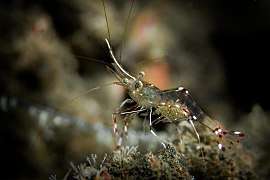Urocaridella renatekhalafae
| Urocaridella renatekhalafae | |
|---|---|
 | |
| Renate Khalaf's Cleaner Shrimp Urocaridella renatekhalafae, Khorfakkan Sea, Gulf of Oman | |
| Scientific classification | |
| Kingdom: | Animalia |
| Phylum: | Arthropoda |
| Subphylum: | Crustacea |
| Class: | Malacostraca |
| Order: | Decapoda |
| Family: | Palaemonidae |
| Genus: | Urocaridella Borradaile, 1915 |
| Species: | U. renatekhalafae |
| Binomial name | |
| Urocaridella renatekhalafae Khalaf, 2018 | |
Urocaridella renatekhalafae is a species of cave clear cleaner shrimp in the family Palaemonidae. It was identified as a species new to science in 2018, and was named in honour of the discoverer's mother, Renate Khalaf.
Description
Urocaridella renatekhalafae grows up to 3 cm in length. The body is transparent with white and red dots on the cephalothorax and abdomen. The inner organs can be seen clearly. The eyes are normally stalked. Legs are slim and long with white and red bands and rings. The red antennas and antennules are long. The very long rostrum is white in colour. Telson and uropod are transparent with white and red rings and dots.
Diet
Renate Khalaf's cleaner shrimp feeds on parasites living on fish, mouth mucous, copepods and food leftovers. It attracts its host by laterally vibrating its red antennas and antennules; and when the fish is ready, it approaches the shrimp, which begins its cleaning service in the so called "cleaning stations".
Habitat
It lives in small crevices and caves in rocky and coral reefs to a depth of 25 meters.
Distribution
Urocaridella renatekhalafae was described from the East Coast of the United Arab Emirates, Gulf of Oman. It is distributed in the Red Sea, through the Indian Ocean and the Western Pacific Ocean.
References
- Khalaf-Prinz Sakerfalke von Jaffa, Norman Ali Bassam Ali Taher Mohammad Ahmad Mostafa & Ola Mostafa Esmail Mostafa Khalaf (2018). "Urocaridella renatekhalafae Khalaf, 2018: A New Cave Clear Cleaner Shrimp Species from the East Coast of the United Arab Emirates, Gulf of Oman, Arabian Sea, Indian Ocean". Gazelle: The Palestinian Biological Bulletin (157): 14–31. ISSN 0178-6288.
External links
- Urocaridella renatekhalafae in ZooBank.
- Urocaridella renatekhalafae in Encyclopedia of Life.
- Urocaridella renatekhalafae in GBIF.